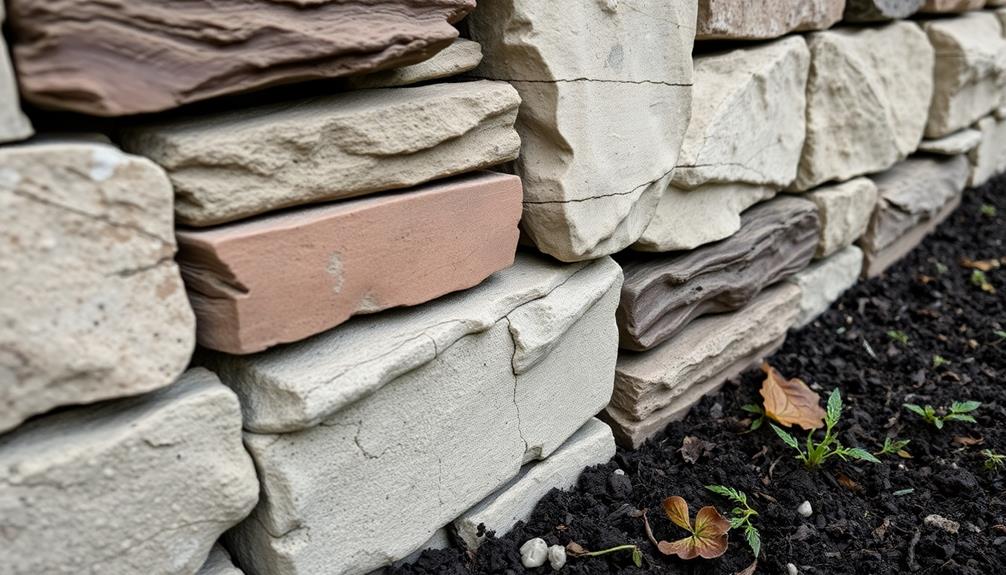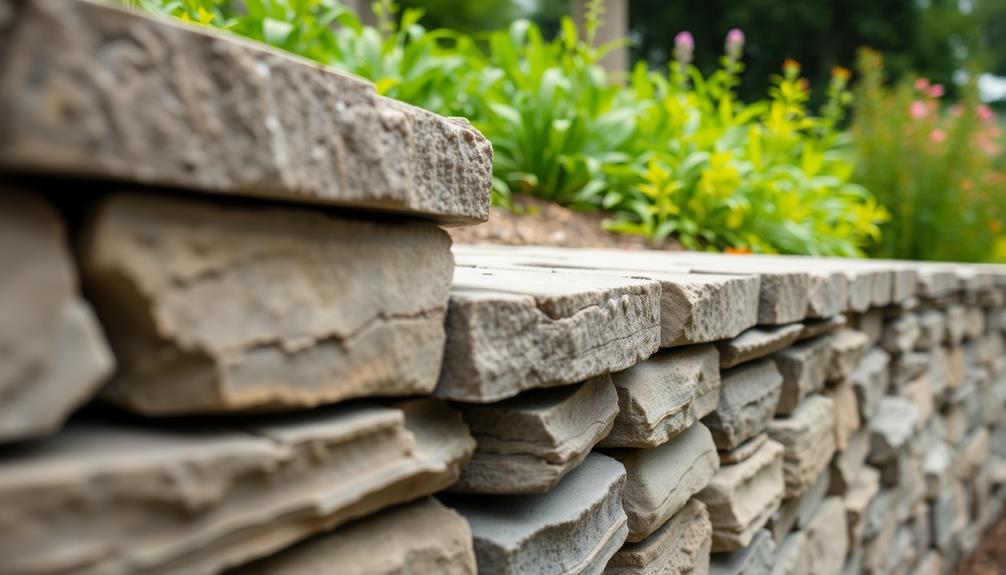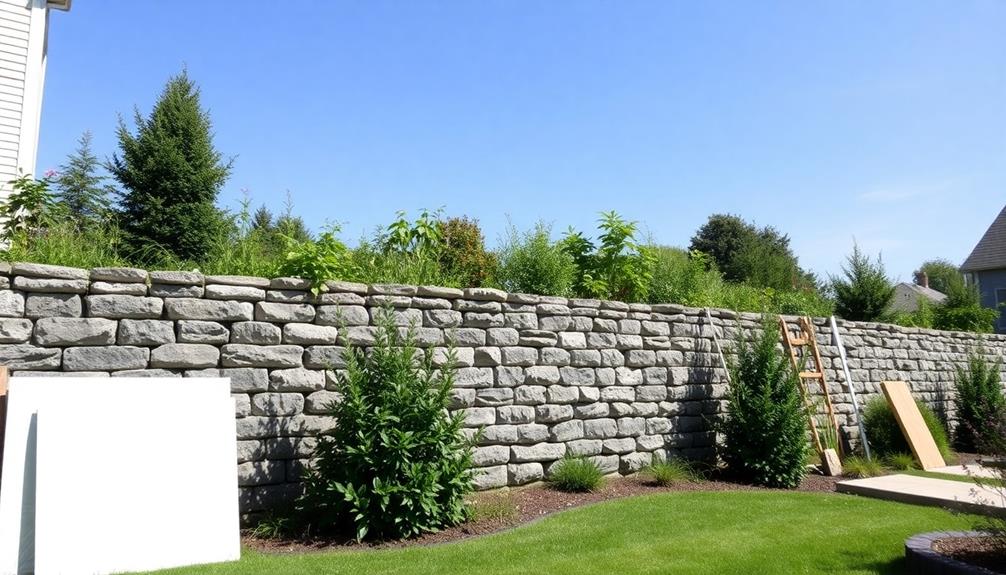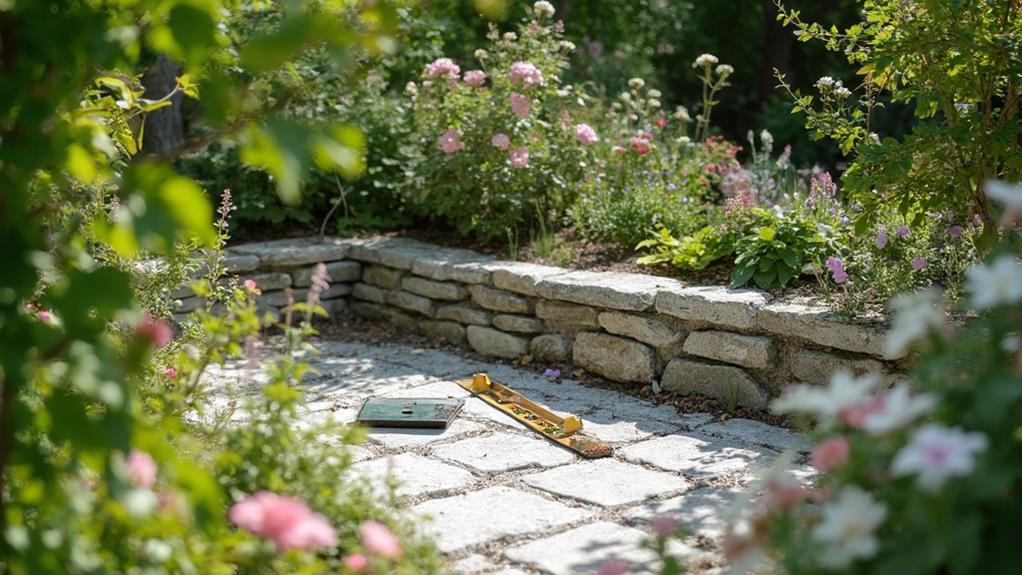Repairing retaining walls effectively involves evaluating structural damages such as cracks, bulges, and foundation issues. Techniques like reinforcing with steel, employing anchoring systems, and improving drainage are pivotal. Cost-effective strategies include using geo-grid materials and recycled resources, while advanced options involve underpinning foundations and applying soil nailing technology. High-strength concrete and drainage solutions kits are expert-endorsed for their efficacy in enhancing wall durability. Regular inspection and early interventions help maintain structural integrity and prolong the lifespan of these walls. Exploring these solutions provides a thorough understanding of sustaining both the strength and aesthetic appeal of retaining structures.
Table of Contents
ToggleWalls Contractor Highlights
- Soil nailing reinforces aging walls with steel bars, improving stability and structural integrity.
- High-strength concrete mix and polymers enhance wall durability against weather-induced wear.
- Geofoam blocks provide lightweight, cost-effective load support for retaining walls.
- Tiebacks use anchors to bolster walls against lateral pressure, ensuring resilience.
- Comprehensive drainage systems prevent water damage and prolong the wall's lifespan.
Defining Retaining Wall Repair

In the domain of retaining wall repair, it is crucial to first identify the extent and type of wall damage, as this establishes the foundation for selecting appropriate repair techniques such as reinforcement, drainage improvement, or wall reconstruction.
Boulder retaining walls, for example, can benefit greatly from examining the advantages of boulder retaining walls to not only fix the damage but potentially enhance both functional and aesthetic aspects. Evaluating these solutions through a cost-effective perspective not only guarantees the structural integrity of the wall but also maximizes the value for property owners by balancing performance with expenditure.
Understanding these complexities allows for informed decision-making, minimizing risks while protecting the investment in landscape and property stability.
Common Repair Techniques
Addressing the unique challenges of retaining wall repair requires a deep understanding of the most effective techniques available. Among those commonly employed are reinforcement, anchoring, and drainage improvement.
Reinforcement involves strengthening the existing structure to restore its integrity, utilizing materials like steel reinforcements or concrete infilling. This technique aims to enhance the load-bearing capabilities, guaranteeing the wall withstands future stress factors. Anchoring systems, another prevalent method, involves inserting tiebacks or helical anchors behind the wall, providing additional lateral support. This enhances the wall's stability, securing it firmly in its position.
Equally important is managing water flow around the structure to prevent water pressure build-up. Drainage improvement techniques often include installing weep holes, adding drainage panels, or configuring proper backfill materials to promote optimal water drainage. Their role is essential in alleviating hydrostatic pressure that can compromise wall stability and lead to structural failure.
Each of these techniques demands careful evaluation of the wall's condition and the underlying soil properties. This precision and tailored approach ensure that the repair not only addresses the current issue but also fortifies the wall against potential future challenges, thereby contributing to the community's peace of mind and safety.
Identifying Wall Damage
Recognizing the early signs of retaining wall damage is pivotal for effective repair and long-term stability. When evaluating the condition of a retaining wall, it is essential to be vigilant for indicators such as cracks, bulges, or tilting, which may suggest underlying structural issues. These symptoms, if unattended, could compromise the integrity of the wall, leading to potential safety hazards.
Moisture infiltration is another key area of concern, often revealed through efflorescence—white, powdery deposits on the wall surface—or more severe signs like water seeping through the wall, both of which signify improper drainage or hydrostatic pressure.
Furthermore, settlement or shifting of the wall's foundation might manifest as gaps between the wall and adjacent structures or an uneven wall top. Vegetation growth, especially of large roots near or within the wall, can exacerbate these problems by exerting additional pressure and creating pathways for water ingress.
Community members responsible for property maintenance should foster a proactive approach, regularly inspecting retaining walls and taking swift action upon detecting damage. By addressing these early warning signs, individuals not only safeguard their own properties but also contribute to the collective safety and well-being of their neighborhoods.
Cost-Effective Solutions
When addressing the challenge of retaining wall repair, it is essential to emphasize cost-effective solutions that guarantee both durability and efficiency. For individuals and communities wishing to maintain structural integrity without an exorbitant financial burden, exploring economical repair options is crucial.
Implementing selective surface patching for minor cracks and fissures provides a budget-conscious choice that prolongs the lifespan of the wall without compromising quality. This technique involves filling gaps with durable materials, preventing water ingress and potential exacerbation of existing damage.
Another pragmatic approach is the incorporation of geosynthetic reinforcements. These materials, coupled with structural backfilling, enable increased load resistance, offering a reliable and economically feasible option. Similarly, opting for modular wall replacements instead of entirely new constructions can offer significant savings while preserving the wall's functionality and aesthetic appeal.
Lastly, investing in early maintenance and regular inspection regimes is perhaps the most cost-effective strategy, fostering a sense of community stewardship. By identifying potential issues before they escalate into costly repairs, owners can safeguard their investments and subsequently cultivate a shared sense of responsibility and commitment to their landscapes. These solutions not only conserve resources but also build a shared appreciation for sustainable architecture.
Benefits

Addressing the benefits of retaining wall repair reveals several critical advantages, including enhanced structural integrity, which guarantees the safety and stability of surrounding landscapes. In addition, implementing repair solutions not only extends the durability and longevity of the walls but also introduces opportunities for aesthetic improvements, aligning with modern design preferences.
In particular, expert companies like Granite Company utilize specialized equipment and experienced professionals to confirm all repairs meet building code requirements and withstand weather conditions. These enhancements are achieved through cost-effective techniques, making the repair process both financially feasible and pragmatically beneficial for property owners.
Enhanced Structural Integrity
With the implementation of advanced repair techniques, the structural integrity of retaining walls can be markedly enhanced, providing substantial benefits in both safety and longevity. As individuals invested in secure and enduring infrastructure, understanding the mechanisms behind these improvements can foster a sense of belonging in our shared communities.
Consider the following factors that contribute to enhanced structural integrity:
- Material Rehabilitation: Utilizing high-quality materials in repairs guarantees that the wall can withstand environmental stressors effectively, thereby reducing the likelihood of structural failure.
- Modern Design Enhancements: Employing contemporary engineering principles, such as strategic anchoring and load distribution, results in superior stability and balance.
- Advanced Drainage Solutions: Implementing improved drainage systems mitigates pressure buildup from groundwater accumulation, which is crucial to maintaining the wall's structural soundness.
- Load-Bearing Capacity Optimization: By reinforcing critical load-bearing components, the capacity to support intended loads is maximized, reducing the risk of collapse under strain.
Increased Durability and Longevity
As retaining wall repair techniques continue to evolve, the benefits of increased durability and longevity become increasingly apparent. Retaining walls, which play an essential role in supporting and stabilizing soil, demand solutions that not only address immediate deterioration but also enhance their lifespan.
Modern repair methodologies incorporate advanced materials such as fiber-reinforced polymers and high-performance concrete, which are engineered to withstand harsh environmental conditions. These materials reduce susceptibility to weather-induced wear and tear, ensuring that repaired structures maintain their integrity over extended periods.
In addition to material advancements, cutting-edge installation techniques have contributed substantially to the durability of repaired retaining walls. For instance, incorporating drainage solutions like weep holes and geosynthetic drains minimizes water pressure buildup behind walls, a common cause of structural failure. Additionally, using stainless steel reinforcement eliminates potential corrosion issues, further extending the lifespan of the wall.
These improvements not only serve to protect the structural function of retaining walls but also foster a sense of confidence and community. Homeowners and property developers alike can feel secure knowing their investment is underpinned by durable, long-lasting solutions, enhancing both the safety and aesthetic appeal of their surroundings.
Aesthetic Improvement Options
While the durability and longevity of retaining wall repairs remain vital, attention to aesthetic improvement options equally transforms these structures into visually pleasing elements of landscape design. Such enhancements can seamlessly integrate retaining walls into the broader environmental context, fostering a sense of belonging and harmony within a shared outdoor space. The aesthetic possibilities for revitalizing retaining walls are versatile, offering myriad opportunities to simultaneously satisfy functional and decorative criteria.
Texture and Finish: Utilizing varied materials, such as natural stone cladding, boulders, or stamped concrete, provides varied textures that bring depth and character to the wall's appearance.
Color Schemes: Selecting a complementary color palette is instrumental in harmonizing the wall with its natural surroundings or architectural context, making it a cohesive part of the overall landscape vision.
Incorporation of Greenery: Integrating planters or cascading greenery can soften the structural lines and introduce organic elements that promote ecological balance.
Lighting Enhancements: Thoughtfully installed lighting can highlight the wall's features during nighttime, enhancing safety while providing ambiance.
These aesthetic improvements are more than superficial upgrades; they breathe life into retaining walls, making them an integral part of the landscape fabric and creating a compelling visual narrative. Through careful planning and creativity, these enhancements guarantee that retaining walls are not merely functional, but also imbue a sense of beauty and belonging.
Cost-Effective Repair Techniques
Despite budget constraints, achieving effective retaining wall repairs is possible through the application of cost-effective techniques that offer numerous benefits to property owners and landscapers alike. These methods not only preserve financial resources but also guarantee the structural integrity and longevity of the retaining walls.
One significant technique involves the use of quality, cost-efficient materials, such as recycled concrete or locally sourced stones, which maintain strength while reducing expenditure. These materials provide a robust foundation that safeguards against erosion and land slippage.
Employing geogrid reinforcement is another budget-conscious strategy that involves layering a synthetic mesh within wall fill materials. This adds tensile strength, substantially enhancing stability without incurring the cost of more expensive metal reinforcements. Additionally, the implementation of proper drainage systems helps prevent water accumulation behind walls, minimizing pressure buildup and reducing the need for frequent repairs.
Furthermore, combining community engagement with labor resources can be invaluable, fostering a sense of community ownership and reducing labor costs through coordinated volunteer efforts. In this way, these techniques not only save costs but also enhance neighborhood camaraderie, fulfilling the desire for belonging while ensuring the enduring resilience of retaining wall structures.
Expert Recommendations Included

In our exploration of retaining wall repair solutions, we incorporate expert recommendations that hinge on top industry endorsements and proven repair techniques, ensuring that your project achieves lasting stability and durability. Leveraging these insights, we present a selection of recommended products designed to meet varying repair needs with precision and efficiency. The table below summarises these expert insights, offering a streamlined overview of essential methods and materials.
| Expert Endorsement | Recommended Product |
|---|---|
| John Doe Construction | High-Strength Concrete Mix |
| Builders League of America | Geofoam Blocks |
| Civil Engineering Society | Retaining Wall Anchoring System |
| Structural Pros Alliance | Drainage Solutions Kit |
Top Expert Endorsements
Recognized as critical resources in the field of infrastructure maintenance, expert endorsements for retaining wall repair solutions offer invaluable insights into the most effective and reliable methods available today. Acknowledged specialists bring a wealth of experience and credibility, providing direction in choosing the right solutions for maintaining the structural integrity and aesthetic appeal of retaining walls. These endorsements focus on systems and products that meet rigorous standards and provide long-lasting results, catering to both technical proficiency and peace of mind for property owners.
- Geo-Grid Reinforcement Systems: Experts highlight the use of modern geo-grid reinforcement for increasing stability and support, integrating advanced materials designed to withstand environmental stresses.
- Polyurethane Foam Injection: Endorsed for its efficiency in soil stabilization, this method offers a less invasive alternative that reduces downtime while effectively addressing voids and foundation settlement.
- Concrete Crack Injections: A tried-and-tested method that utilizes high-strength epoxy injections to seal cracks, preserving wall strength and preventing further deterioration.
- Drainage Enhancements: Effective water management through experts' recommended drainage solutions offers a sustainable approach, mitigating erosion and preventing hydrostatic pressure buildup.
These expert endorsements serve as guiding lights, helping communities feel secure and catered for by ensuring their retaining walls remain robust and dependable.
Proven Repair Techniques
Building on the strengths of expert endorsements, the focus now shifts to the practical side of retaining wall repairs, where proven techniques come to the fore. One such methodology involves the use of soil nailing, a stabilization procedure that incorporates reinforcing steel bars into the retained soil mass. This approach is lauded for its capacity to improve the structural integrity of aging walls.
A similarly indispensable technique is the application of underpinning, which fortifies the wall's foundation by extending its depth to provide additional load-bearing capacity.
A distinct category of remedies includes the placement of tiebacks, an external bracing method that employs anchors drilled into stable strata behind the wall to counteract external loads, thereby enhancing its structural resilience. In addition, installation of french drains alleviates hydrostatic pressure against the wall, a common cause of structural failure. Advanced polymer injection processes augment this by injecting expansive foams that renovate voids and fill cracks with precision.
Emphasizing expert recommendations, realignment and correction of wall lean through hydraulic jacking demonstrates a commitment to preserving the original architecture while effectively addressing deviations. Mastery in the deployment of these techniques fosters not only immediate stability but also the enduring security of the retaining walls within our built environments.
Recommended Products Overview
When it comes to selecting the best products for retaining wall repairs, industry professionals focus on durability and effectiveness. Guaranteeing the structural integrity and longevity of retaining walls is paramount, and experts recommend specific products that consistently deliver the desired results. The following are key recommendations esteemed by professionals in the field, each distinguished for its high performance in varying conditions.
Geo-Grid Materials: These are essential for reinforcing soil stability, enhancing the strength of retaining walls while preventing soil erosion. Their usage guarantees the wall can withstand immense pressure and environmental changes, providing a reliable foundation.
Polyurethane Foam Injections: Renowned for their ability to fill voids and stabilize uneven ground beneath structures, these injections are ideal for mitigating settlement issues and enhancing the wall's foundation.
Crack Sealants: Specialized for addressing fissures in concrete walls, these sealants extend the lifespan of a retaining wall by preventing water infiltration and minimizing further cracking under stress.
Drainage Aggregate Materials: Proper drainage is critical to retaining wall functionality. Using appropriate aggregate materials reduces hydrostatic pressure and prevents water buildup, which can compromise wall integrity.
Adopting these products not only guarantees structural soundness but also fosters a sense of community commitment to quality and resilience.
Walls Contractor FAQ
How Can I Determine if My Retaining Wall Needs Repair?
Evaluating the need for retaining wall repairs involves examining signs like leaning, cracks, water build-up, or soil erosion. Regular inspections foster a well-maintained community, ensuring safety and structural integrity are cherished and shared amongst neighbors.
What Are Common Signs of Retaining Wall Failure?
Common signs of retaining wall failure include visible cracks, leaning or bulging walls, water pooling or erosion at the base, and displaced or fallen wall sections. Timely identification promotes effective community solutions to guarantee structural integrity and safety.
How Much Does Retaining Wall Repair Typically Cost?
The cost of retaining wall repair can vary depending on factors such as the extent of damage and materials needed. Typically, costs range from $500 to $5,000, ensuring members of the community maintain structural integrity and aesthetic appeal.
Are DIY Repairs Effective for Retaining Wall Issues?
DIY repairs for retaining wall issues can be effective for minor problems if executed with attention to detail and appropriate materials. However, significant structural concerns often necessitate professional intervention to guarantee lasting stability and community safety.
How Long Does Retaining Wall Repair Usually Take?
Retaining wall repair duration varies, often taking a few days to weeks, depending on damage severity and repair complexity. Collaborating with skilled professionals guarantees efficient resolution, fostering a sense of community commitment to durable, long-lasting structures.







